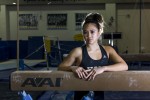The redshirt sophomore gymnast mounted onto the high bar, grabbed hold and let her body swing. She kicked herself up vertically and released her hands to reach out and grab the lower bar. After her double layout dismount, she was met with the winning score and her team’s collective embrace.
It appeared to more than 2,000 fans in attendance at UCLA’s season opener at Gill Coliseum in Corvallis, Ore. like just another standout performance of the night. But for her, the 26-second routine was many years in waiting.
Christine Peng-Peng Lee was back.
The fall before the rise
Lee, as a senior in high school, was already the top competitor for Canada going into the 2012 Olympic Trials.
Everything was going according to plan for Lee at the Olympic Trials. She had already qualified for the Olympic team, and was merely going through a practice event just two months before the 2012 summer games. But Lee’s path to the Olympics took a drastic turn at the 2012 Canadian National Championships.
Lee ran toward the vault, just as she had countless times before, but as soon as she landed on her double-twisting Yurchenko, she knew something was seriously wrong.
“My knee completely came out,” Lee said.
Lee tore her anterior cruciate ligament as well as her medial collateral ligament on her left knee, both of which are integral to physical stability and mobility.
The injury is usually fatal to a gymnast’s already limited career span.
“I knew that it was going to take a year, that was a given,” Lee said.
To get back, Lee would have to commit herself to a strict rehab regimen for the next ten months. It was an investment that she said she was willing, and eager, to make.
Coping
Lee came to UCLA in fall 2012 for gymnastics, even though she was in the midst of her injury and unable to compete.
Without being able to use gymnastics as an outlet, Lee had to find alternative forms of dealing with her injury at the start of her college experience.
During team meets, she would talk to the gymnasts to calm them down and instill confidence in them. She would also assume a role as the team’s personal stylist and makeup artist, trying to suit them up as performers and not just gymnasts.
“It’s funny because I would have a schedule – like you can come in at this time and this time,” Lee said with a laugh.
It wasn’t Lee’s official job, but it became her job. It created a role for her on the team while she wasn’t competing.
“Makeup, hair and leotards are big part of gymnastics,” said Jordyn Wieber, UCLA’s team manager and a gold medalist for team U.S.A. in the 2012 Summer Olympics. “And (Lee) is so good at it.”
Aside from her casual part-time job as a makeup artist, Lee kept herself busy with other activities, whether it was cooking, singing, practicing guitar or filming music videos.
Another setback
Lee’s rehabilitation looked to set her on track for a return during her freshman year, until she noticed an unusual feeling in her left knee once again. It wasn’t a re-tear of her ACL or MCL, but something was off.
“I did a leap on floor and (my left knee) gave out again. So I was like, ‘something is wrong,'” Lee said. “Cause it shouldn’t (have been) this loose.”
After a consultation with a doctor, Lee was met with some news that would once again turn her career off course: The graft in her left knee was not functioning properly.
Another surgery was needed, so Lee had to sit out for another year. “I think that was more upsetting than the Olympic year (injury), because I was about to come back and you know (that) it’s another year (of rehab),” Lee said.
Lee didn’t allow her injury setback to compromise her determination or resolve. She still retained the goal of competing at UCLA and being a student-athlete, and she would do all she could to realize that goal.
“A lot of people take what they had before and compare, but its really hard if you compare because that’s your old self and this is you now,” Lee said. “I never really compared myself to when I was younger because it’s a waste of time. I am always thinking about how I am going to improve and get stronger.”
Realization of the return
Throughout the two-and-a-half-year hiatus, Lee never ceased to practice, and when she could not physically perform the skills due to knee pain, she would mentally visualize her routines. This way, she retained her muscle and mental memory, and this was also her way of doing what she loved – gymnastics. Lee visualized her routines repetitively, dreaming of her days in competition.
“I have already done it so many times in my head that as soon as I am ready physically, I can just go out and do it.” Lee said.
But more importantly, Lee learned a lot about her teammates and herself during her break.
As her role altered to a team spirit force by working hard on her own rehabilitation and experimenting with her skills to the best of her capacity, Lee became both a teammate and a competitor.
“She gives a lot of energy to this team,” said redshirt senior Samantha Peszek, Lee’s fellow teammate and roommate.
Lee’s 9.900 score on bars was followed by a 9.875 finish on beam. It was a successful college debut for Lee, one that didn’t escape the eyes of her father, Kin-Man Lee.
“Having been away for such a long time, and coming back as an older gymnast, we really didn’t know what to expect,” Kin-Man Lee said. “But we are happy for her and we are very proud that she has been persistent.”
Now, as a regular on the team, Lee is starting her gymnastics career on a clean slate after overcoming years of adversity.

Good article.